In September 2009, a powerful tsunami generated by an undersea earthquake killed dozens and wiped out several villages in the Pacific islands of Samoa, American Samoa, and Tonga. Amanda and John Neal (s/v Mahina Tiare) were in the Samoan capital, Apia.
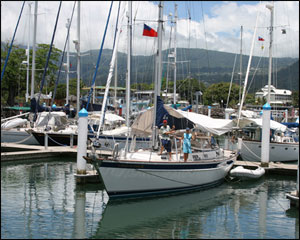 |
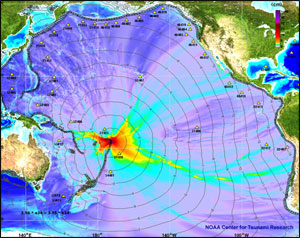 |
| MAHINA TIARE in Apia Marina – Samoa | Samoan tsunami (Credit NOAA / PMEL / Center for Tsunami Research ) |
Samoa
“Earthquake?!” we said to each other.
“Not a bad one” John commented as the ground continued to roll and shake.
“Hum” I thought as I wondered how crew are faring back aboard Mahina Tiare in Apia Marina.
The previous day, Monday 29th September we’d cleared into Samoa with our expedition crew of six after completing the 180 mile passage from Niuatoputapu, Tonga.
 That night we’d all gone to bed rather pooped so when John and I left on a dawn run to reacquaint ourselves with downtown Apia I was surprised to see most of our crew awake and heading for the showers.
That night we’d all gone to bed rather pooped so when John and I left on a dawn run to reacquaint ourselves with downtown Apia I was surprised to see most of our crew awake and heading for the showers.
As John and I left Farmer Joes supermarket with an armload of hot bread, the street started shaking.
I looked around thinking a truck was passing by but saw no heavy equipment. I was a little behind John, I’d been peering in a shop window, so I ran to catch him up for he was now standing in the middle of the street.
“Quick, we’d best leg it back to the boat!” I said.
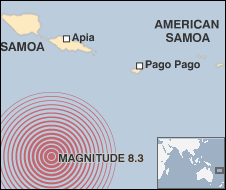 |
| Location of the earthquake (Map from the website news.bbc.co.uk) |
We quickly made the ten minute run back to Mahina Tiare, keeping clear of all tall buildings and power lines. My eyes were fixated on the harbourfront watching for any signs of receding water.
In 1977 I’d experienced a 7.7 earthquake while in the small boat basin in Nukulofala, Tonga, aboard our family cruising yacht Swanhaven. It occurred at 2am and all the cruisers had stood on deck in the dark discussing the possibility of a tsunami. One did not eventuate but I was now wondering the same as we ran back to the marina.
We arrived back at Mahina Tiare to find our crew in good spirits.
I chatted with Elaine who said as the quake struck she had awoken to a strange jiggling. After going to the cockpit she looked about as other cruisers appeared on deck. As the quick jiggling motion continued for several minutes everyone then assumed it was an earthquake. After chatting with Elaine and our crew for a few moments I went aft to gather my shower kit.
It was a tsunami alert.
Suddenly loud civil defense sirens sounded. It only took a minute to register what it meant, then only a few seconds to realize it was a tsunami alert.
“Grab your passports and run” I told our crew.
I set about shutting ports and hatches while John gathered boat papers and our passports. Marina staff was now yelling urgently for everyone to run for the hills and fire truck sirens were also joining in with the civil defense warning. We had to make a quick decision.
“Do we run or put to sea?” asked John and I to each other.
We noticed the water in the marina had started to move about and had quickly dropped four feet. Sea water was surging up and down, dropping only slightly lower after each surge.
We watched across the dock as Ernie and Charlene on Lauren Grace, a Knysna 440 catamaran, took off slewing sideways out the marina with the powerful current sweeping them out. One of the Pago Pago car ferries also cast lines and departed.
 |
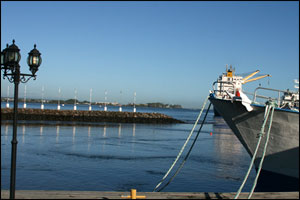 |
| Lauren Grace leaving the marina | Note the receeding water on the marina breakwater |
When we were entering the marina we’d discovered that the marina entrance is very shallow; we only had a depth of 1.7 feet under the keel in places, and numerous large unmarked coral heads dot the marina basin and even some slips.
Would we now have enough depth to leave, and what if we got stuck on a coral head?
We decide to run.
This meant running along the waterfront for three blocks to reach the first road going inland. The smart yachties headed for Aggie Grey’s hotel in the middle of the waterfront bay, where hotel staff welcomed them and sent them to the top floors of the five storied building. Here they had a great view of the harbor going dry for several hundred yards out.
John and I soon joined a mass of people, cars and trucks all heading up the hills.
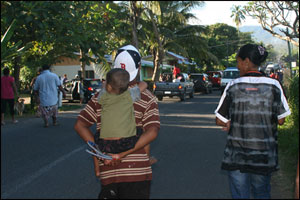 |
 |
| Joining the evacuation heading up the hill |
Heading up the hill. Note ferry and yacht in the distance putting to sea |
Although the fire department kept directing everyone further inland we decided there was no way a tsunami would go further than where we were so we took shelter in the courtyard of a church.
An 18’ tsunami hit the entire South side of the island.
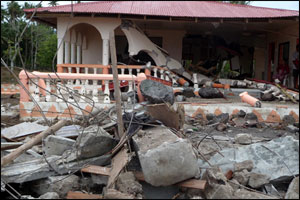 |
 |
| Tsunami damage on the South coast of Upolu Island, Samoa (Photos: Jill Josselyn) |
After half an hour we stopped a passing taxi heading back to the harbour to see if he had any news.
He mentioned that the radio said a tsunami had struck the Eastern end of the island and that a school had collapsed with at least three children dead and more were trapped in the wreckage.
Little did we know that as the sirens went off an 18’ tsunami hit the entire South side of the island causing 130+ deaths and massive destruction.
John and I quickly assumed that a tsunami can’t hit both sides of an island and went back to Mahina Tiare. We’ve since learned that tsunamis in fact can wrap around islands.
Back to Mahina Tiare
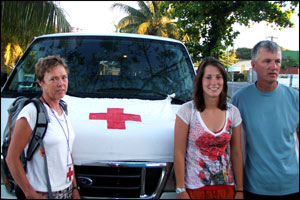 |
| Our crew, Jill, Molly and Roy volunteer at Red Cross |
Our crew had been offered rides inland and were not able to return until around noon due to police road blocks and no final all-clear given over the radio or sirens system.
Relieved to be safe we then spent a few hours calming our nerves while completing medical class, sewing and splicing. Molly, Jill and Roy decided to volunteer at Red Cross and headed off in their rental truck while the rest of us choose to stay put.
Second alert
 |
| John putting on his running shoes as we leave the marina |
When the tsunami sirens went off again around 6 pm, the police and fire trucks came roaring down the harbour front yelling that everyone must leave immediately.
This time three yachts headed out to sea while we headed to Aggie Gray’s Hotel where the staff welcomed us and asked us to hurry up the stairs to one of the top floors. We met a nice couple from Auckland who let us stay on their balcony which had an excellent view of the marina and harbor.
When we switched on the TV to view the news we found the local coverage of the tsunami quite amateurish and disturbing. It was rather indiscriminant with images of distraught families and deceased bodies in piles so we turned it off.
Thankfully after an hour of nothing much going on along the deserted waterfront word of the “All Clear” filtered up to us.
As we returned to the marina Ernie from Laura Grace said that he’d just overheard a conversation on the VHF from the RNZ Air Force P-3 Orion aircraft that had been searching for bodies. They said another tsunami was expected in 20 minutes.
We quickly returned to Mahina Tiare to grab some more things including the handheld VHF. As we switched it on we overhear the NZAF pilot on the VHF asking Apia Port Control for an update on the now imminent tsunami. Port Control said that the last warning was for high waves on the village on the South side of the island that has been devastated and the alarm should not have been sounded again for this side.
Whew! That night we slept with our knapsacks and running shoes in the cockpit ready to sprint back to Aggie Grey’s Room 313 where our Kiwi friends have invited us to return if necessary.
The days after
Wednesday and Thursday in Apia seemed rather normal but fairly quiet as no government offices were open.
Other than the small local morning paper and radio news rebroadcast from Radio New Zealand once a day, getting local news was difficult. It was certainly hard to know what is happening if one didn’t speak Samoan so we found it best to search the internet for updates.
The airport and flights were running nearly to schedule so our crew managed to fly home. There weren’t any shortages of supplies and outside aid continually arrived on military flights. The Samoan prime mister returned from overseas and the New Zealand prime minister arrived aboard a RNAF 757 containing a portable desalinization plant, Samoan-speaking medical personnel, emergency supplies and rescue sniffer dogs.
Kalalau, a sloop from Seattle, left Thursday loaded to the gunnels with supplies for Niuatoputapu,Tonga, and several other yachts planned on making the 180 mile passage there once news was received of the required supplies. The Tongan government patrol boat with medical personnel arrived a few days after the tsunami followed by French naval ship from Noumea.
In the meantime two yachts in the anchorage were a vital communications link to a government-chartered plane that was sent to survey the damage in Niuatoputapu. It could not land as debris had covered the airport runway and telecommunications services were badly affected.
Happy and thankfully safe in Apia Marina
In need of a break John and I are chose an anchorage in small bay to the East of Apia for a few quiet days to work on Mahina Tiare. We listened in on the morning SSB cruisers net to see how everyone fared especially the yachts in Pago Pago and Niuatoputapu and talked a lot together about Tuesday’s events.
We know we made the right decision to run but realized we now needed to so some more research on earthquake and tsunami response.
What we did learn from Lauren Grace is that you need to go to sea to a depth of 100-150’ to be safe but after hearing of the yachts in Pago Pago that got tragically hit by the tsunami you’d best be quick.
Hawaii
27th February 2010: Hawaii is under tsunami warning following a massive earthquake in Chile. Amanda and John are there!
Last Saturday morning at 6am tsunami warning sirens roused John and I from our sleep in oceanfront condo in Hilo, Hawaii. We instantly leap out of bed and proceeded to grab important documents, including our computers, and switch ourselves into evacuation mode.
In checking with our neighbors we were informed we had a leisurely four hours to evacuate before the expected tsunami from a devastating Chilean earthquake was to arrive.
Phew, not like Samoa though even without crew or a vessel to be responsible for it was still a little nerve wracking. We had friends in the Galapagos and knew they would also be affected.
So this week in order to become better educated on earthquake and tsunamis John and I began doing some research. In reviewing our actions in Samoa there was a lot we didn’t know and now wish we had.
In order for others to be better educated we’ve written the following earthquake/tsunami procedures…
| Next post: “Earthquakes & tsunamis – Part 2: lessons learned in Samoa.“ |
March 13, 2010
Amanda Swan Neal
About Amanda Swan Neal
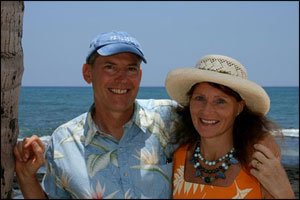 |
| John and Amanda Neal |
With over 237,000 miles, including Sydney-Hobart Races and numerous Cape Horn roundings, Amanda Swan Neal’s offshore sailing started before she was a teen with a family cruise through the South Pacific and on to Seattle.
Upon returning to New Zealand she became a sailmaker and rigger, completing the 1990 Whitbread Around the World Race aboard Maiden.
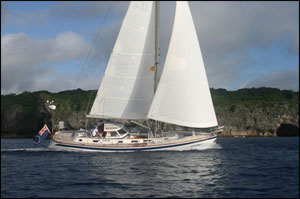 |
| s/v MAHINA TIARE |
In 1994 she fell in love with John Neal or perhaps Mahina Tiare II‘s passage to Antarctica.
Together they run Mahina Expeditions annually conducting 8 intensive offshore sail-training expeditions aboard their Hallberg-Rassy 46 Mahina Tiare III, presentations at major boat shows, and several Offshore Cruising Seminars.
Mahina Tiare‘s 2010 expedition circuit in will be in the South Pacific from New Zealand to Tahiti then weaving through the South Sea Isles to New Caledonia before returning to New Zealand.
Author of The Essential Galley Companion, Amanda writes the monthly “Galley Essentials” article for 48 North magazine and has contributed to Blue Water Sailing, Cruising World, Latitude 38 and Sail Magazine.
When not enlightening others with the joys of sailing Amanda can be heard Celtic step dancing or seen out paddling.
Related articles
- Earthquakes & tsunamis – Part 2: lessons learned in Samoa
- Read what Amanda Swan Neal had to say in our Galley Advice from 18 Cruising Women article.
More info
- Mahina Expeditions website: www.mahina.com
- Amanda will be giving seminars at the Strictly Sail Pacific Boat Show April 15 – 18, 2010 in Oakland CA. We will be publishing details here on our blog soon. View the complete Seminar Schedule.


WOW! I am not a sailor, but have family in Apia. I loved reading your blog about that day. And then you were in Hawaii during the Chile earthquake? I am looking forward to seeing you/your presentation in Oakland. Hopefully, no big disasters are following your passage to the mainland!